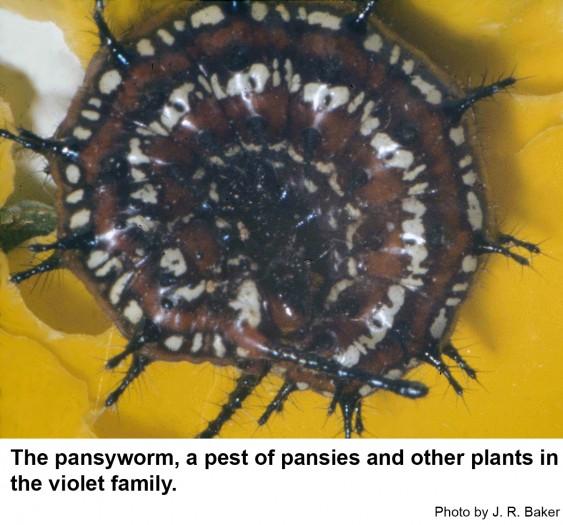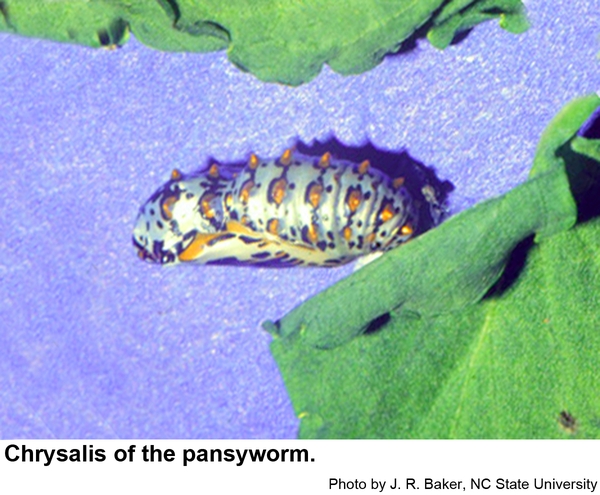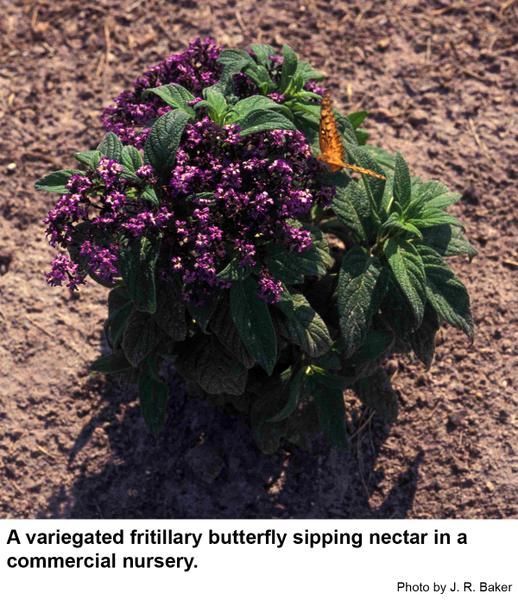Description and Biology
The larvae of the variegated fritillary, Euptoieta claudia, are small, orange to red, spiny caterpillars appropriately called pansyworms because they are most frequently reported from pansy. The caterpillars also feed on a variety of wild flowers and even plantain. Pansyworms are the immature stage of one of a group of four-footed butterflies called fritillaries. Pansyworms overwinter as caterpillars that feed on pansy, violet, alyssum, Johnny-jump-up and other plants in that family. Their butterflies are also reported to overwinter further south. Here variegated fritillaries are in flight from early spring to late fall. In spring the caterpillars molt into a chrysalis (pupa) and from that stage emerges a new generation of orange butterflies with checkered or spotted wings called variegated fritillaries. The pansyworm chrysalis is unusual: it has tubercles that appear to have been plated with pure gold! The males “patrol” for females. After mating, females lay cream to pale green eggs on the host plant. The larvae eat leaves, flowers, and even stems. We have two or three generations per year in North Carolina.
Host Plants
Pansyworms are most frequently reported from pansy although the caterpillars feed on a variety of wild flowers and even plantain. The caterpillars feed the leaves, flowers, and even stems of pansy, violet, alyssum, Johnny-jump-up and other plants in the violet family.
Residential Recommendation
These butterflies are not particularly rare, and they range all over the United States except the Pacific Northwest so it shouldn't be a great shock to find them feeding on pansies here. Because they also feed on a wide range of wild flowers and other forbes, they are not resistant to pesticides. Pyrethroids, Sevin or some other properly labeled insecticide should give adequate control. When used as directed, pyrethroids are very toxic to insects but are not particularly hazardous to humans and pets (other than fish-avoid using pyrethroids around pools, ponds, and streams).
References
- Variegated Fritillary, Euptoieta claudia (Cramer, 1776). Anonymous. 2018. Butterflies and Moths of North America, collecting and sharing data about Lepidoptera.
- Butterflies and Moths (A Golden Guide from St. Martin's Press). Mitchell, R. T., H. S. Zim. St. Martin's Press. 160 pp.
- Euptoieta claudia. Anonymous. 2013. Wikipedia, The Free Encyclopedia.
- Extension Plant Pathology Publications and Factsheets
- Horticultural Science Publications
- North Carolina Agricultural Chemicals Manual
For assistance with a specific problem, contact your local N.C. Cooperative Extension Center.
This Factsheet has not been peer reviewed.
Publication date: May 7, 2013
Reviewed/Revised: Oct. 9, 2019
Recommendations for the use of agricultural chemicals are included in this publication as a convenience to the reader. The use of brand names and any mention or listing of commercial products or services in this publication does not imply endorsement by NC State University or N.C. A&T State University nor discrimination against similar products or services not mentioned. Individuals who use agricultural chemicals are responsible for ensuring that the intended use complies with current regulations and conforms to the product label. Be sure to obtain current information about usage regulations and examine a current product label before applying any chemical. For assistance, contact your local N.C. Cooperative Extension county center.
N.C. Cooperative Extension prohibits discrimination and harassment regardless of age, color, disability, family and marital status, gender identity, national origin, political beliefs, race, religion, sex (including pregnancy), sexual orientation and veteran status.

-r86.jpg)

-r86.jpg)

